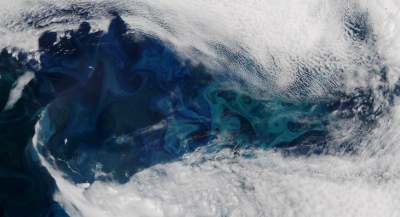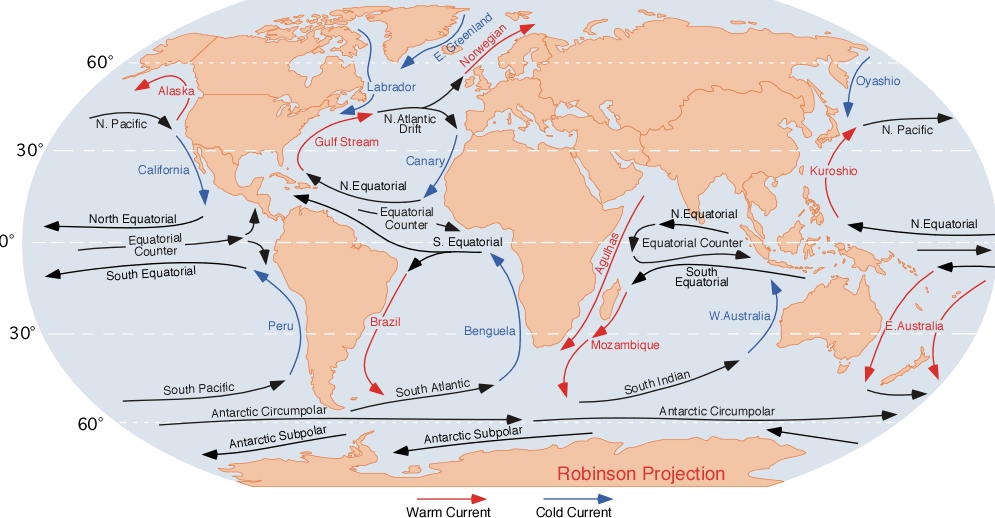The ocean is one of Earth's largest ecosystems, covering 71% of the planet's surface.
The ocean is home to countless biomes and ecosystems, and ocean currents are a crucial component of these ecosystems. Ocean currents have a profound impact on the marine ecosystem because they determine climate, water temperature, salinity, and nutrient distribution, which in turn influences the biomes and ecosystems within it.
What are ocean currents?
Ocean currents refer to the movement of water within the ocean, typically caused by factors such as wind, tides, and the Earth's rotation. Ocean currents can be categorized as surface currents and deep currents. Surface currents are primarily driven by wind and flow at relatively high speeds, typically confined to the surface 200-300 meters. Deep currents, primarily caused by differences in density and pressure, flow at relatively low speeds, typically occurring below 1,000 meters in the deep ocean.
Ocean currents can be categorized as global currents and regional currents. Global currents are distributed throughout the world's oceans and are the primary mode of movement within the ocean. Regional currents are confined to specific regions and are significantly influenced by topography and environmental factors.
The Impact of Ocean Currents on the Marine Ecosystem
Ocean currents have a significant impact on the marine ecosystem. Below, we will discuss these issues from the perspectives of climate, water temperature, salinity, and nutrients.
1. The Impact of Ocean Currents on Climate
Ocean currents affect climate primarily by regulating ocean surface temperature. When warm ocean water flows to higher latitudes, the climate becomes warmer and more humid. When cold ocean water flows to lower latitudes, the climate becomes drier and colder.
For example, the East China Sea Warm Current, a warm current flowing eastward from the South China Sea to the East China Sea, brings abundant moisture and heat, contributing to a warm and humid climate in the East China Sea. In the Arctic, the Greenland Current and the East Greenland Current bring large amounts of cold water and sea ice, making the region extremely cold.
2. The Impact of Ocean Currents on Water Temperature
Ocean currents play a crucial role in regulating the distribution and variation of seawater temperature. Ocean currents carry water of varying temperatures to different locations, thus affecting the distribution of water temperatures within the ocean.
For example, the presence of the East China Sea Warm Current contributes to relatively high water temperatures in the East China Sea. The Prospector Seamount Current in the North Pacific has caused extremely low water temperatures in some areas, sometimes even below 0°C, resulting in frozen oceans.
Changes in water temperature directly affect the survival and reproduction of marine life. Some marine organisms, such as whales and seals, require specific water temperatures and depths for growth and reproduction.
3. Impact of Ocean Currents on Salinity
Ocean currents also play a significant role in the salinity distribution of seawater. This salinity distribution is also a key factor influencing marine ecosystems, as different organisms have different adaptations to salinity.
For example, the surface waters of the Atlantic Ocean are salinier than those of the Indian Ocean. Because of the higher salinity of the Atlantic Ocean, deeper waters, unlike those in other oceans, sink to the bottom of the Atlantic Ocean, forming the Atlantic Deep Water. Currents and changes in the deep waters of the Indian Ocean influence its salinity distribution.
4. Impact of Ocean Currents on Nutrients
Ocean currents also play a crucial role in regulating the distribution of nutrients in the ocean. Nutrients, including elements such as silicon, nitrogen, and phosphorus, are essential for the growth and reproduction of marine life. Ocean currents allow nutrients in seawater to be mixed and distributed to different locations. For example, the Equatorial and Sub-Equatorial Currents in the equatorial region mix and distribute nutrients to the central Pacific Ocean, forming one of the world's largest marine biomes: the Pacific Ocean food web.
The distribution and changes of nutrients have significant impacts on marine ecosystems and fisheries. Nutrient-rich waters tend to have higher fishery yields and more abundant marine ecosystems.



